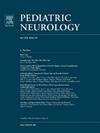Functional Syncope in Children and Adolescents: A Retrospective Cohort Study
IF 3.2
3区 医学
Q2 CLINICAL NEUROLOGY
引用次数: 0
Abstract
Background
Functional syncope, or psychogenic pseudosyncope, is often under-recognized. We aimed to show that functional syncope may be diagnosed in most pediatric patients by the initial neurological consultation.
Methods
We reviewed the medical records of patients who were evaluated from 2006 to 2022 in clinic for apparent transient loss of consciousness (a-TLOC) and probable functional syncope. Inclusion criteria included the following: (1) one or more episodes of a-TLOC; (2) spontaneous recovery; (3) age <19 years; (4) patients collapse or lie immobile andunresponsive to verbal stimulation; (5) normal or mildly increased heart rate and blood pressure, if assessed; (6) no other medical causes; and (7) episodes occurred during tilt, electroencephalography, or electrocardiogram or were seen by the author on a smartphone video or in clinic. Patients meeting criteria 1 to 7 were classified as “definite” functional syncope and those meeting criteria 1 to 6 as “probable” functional syncope.
Results
We identified 31 patients with a-TLOC: 26 (23 females) had functional syncope, aged six to 17 years, whereas five were excluded (two functional seizures, one temporal lobe epilepsy, one vasovagal syncope, and one asthma). The clinical features of 13 patients in each group (definite versus probable) were not different statistically. Episodes were prolonged (1 to 270 minutes, mean 58 minutes) and frequent (daily or weekly in 65%), with eyes closed in 71% and eye flutter in 27%. After mean follow-up of 15 months in 14 patients: episodes disappeared in 29%, decreased >50% in 36%, and remained the same in 36%.
Conclusions
Functional syncope can be diagnosed at the initial neurological consultation without additional diagnostic testing in most patients.
儿童和青少年功能性晕厥:回顾性队列研究
背景:功能性晕厥或精神性假性晕厥往往未被充分认识。我们的目的是证明大多数儿科患者的功能性晕厥可通过神经科初诊诊断出来:我们回顾了 2006 年至 2022 年期间因明显的一过性意识丧失(a-TLOC)和可能的功能性晕厥而接受门诊评估的患者的病历。纳入标准包括以下几点:(1) 一次或多次发作 a-TLOC;(2) 自发恢复;(3) 年龄 结果:我们发现了 31 名 a-TLOC 患者:26 人(23 名女性)患有功能性晕厥,年龄在 6 至 17 岁之间,5 人被排除在外(2 名功能性癫痫发作患者、1 名颞叶癫痫患者、1 名血管迷走性晕厥患者和 1 名哮喘患者)。每组 13 名患者的临床特征(明确与可能)在统计学上没有差异。发作时间长(1 至 270 分钟,平均 58 分钟),频率高(65% 的患者每天或每周发作一次),71% 的患者闭眼,27% 的患者眼球跳动。对 14 名患者进行平均 15 个月的随访后发现:29% 的患者发作消失,36% 的患者发作次数减少 50%以上,36% 的患者发作次数保持不变:大多数患者在初次神经科会诊时即可诊断出功能性晕厥,无需额外的诊断测试。
本文章由计算机程序翻译,如有差异,请以英文原文为准。
求助全文
约1分钟内获得全文
求助全文
来源期刊

Pediatric neurology
医学-临床神经学
CiteScore
4.80
自引率
2.60%
发文量
176
审稿时长
78 days
期刊介绍:
Pediatric Neurology publishes timely peer-reviewed clinical and research articles covering all aspects of the developing nervous system.
Pediatric Neurology features up-to-the-minute publication of the latest advances in the diagnosis, management, and treatment of pediatric neurologic disorders. The journal''s editor, E. Steve Roach, in conjunction with the team of Associate Editors, heads an internationally recognized editorial board, ensuring the most authoritative and extensive coverage of the field. Among the topics covered are: epilepsy, mitochondrial diseases, congenital malformations, chromosomopathies, peripheral neuropathies, perinatal and childhood stroke, cerebral palsy, as well as other diseases affecting the developing nervous system.
 求助内容:
求助内容: 应助结果提醒方式:
应助结果提醒方式:


